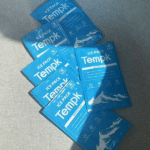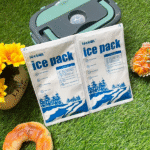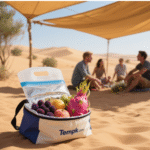دراي آيس باك للتسوق عبر الإنترنت مرشد 2025
دليلك الشامل للشراء, تعبئة وشحن المنتجات المجمدة بشكل آمن, قانونيا وفعالا من حيث التكلفة.
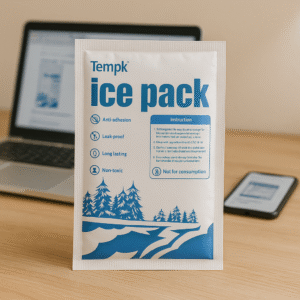
-
لماذا لا تزال عبوات الثلج الجاف مهمة في عام 2025
-
حاسبة سريعة: ما هي كمية الثلج الجاف التي تحتاجها؟?
-
قائمة مراجعة الشراء خطوة بخطوة
-
التعبئة & أفضل ممارسات الشحن
-
2025 يكلف & المأجورون الاستدامة
-
التكنولوجيا الناشئة & اتجاهات السوق
-
المزالق المشتركة (وإصلاحات سهلة)
-
الأسئلة الشائعة
-
الوجبات الرئيسية & الخطوات التالية
1. لماذا عبوات الثلج الجاف لا تزال مهمة في عام 2025
ضمن أول 50 كلمة نجيب على القصد:
عبوات الثلج الجاف (ثاني أكسيد الكربون الصلب عند -78.5 درجة مئوية أو بدائل PCM منخفضة للغاية) تبقى فقط طريقة قابلة للتطوير للحفاظ على الطعام, المواد البيولوجية أو مجموعات الوجبات المجمدة لمدة تتراوح من 48 إلى 72 ساعة من الباب إلى الباب - خاصة وأن النمو السنوي بنسبة 31٪ في البقالة الإلكترونية المجمدة يعرض الشحنات إلى فترة أطول, طرق أكثر سخونة.
Key numbers
| متري (2025) | قيمة | لماذا يهم |
|---|---|---|
| Global dry‑ice market | US $1.57 B, CAGR 6.9 % | Growing demand means more suppliers—& more noise |
| FDA “frozen” threshold | ≤ –18 °C | Dry ice easily beats this for 72 h |
| Average daily sublimation | 2-4.5 كجم لكل 24 ساعة (insulated 25 L shipper) | Core input for cost & weight planning |
2. Quick Calculator 🔢
قاعدة الإبهام
Dry‑ice weight (كجم) = Transit hours ÷ 24 × 4 kg × 1.2 (عازلة السلامة)
مثال
A 60 h ground route → 60 ÷ 24 = 2.5 d → 2.5 × 4 kg = 10 kg → × 1.2 ≈ 12 kg of dry ice.
3. Step‑by‑Step Buying Checklist 🛒
| خطوة | What to Verify | للنصيحة |
|---|---|---|
| 1. Supplier EEAT | ISO 9001, UN 1845 label print, downloadable SDS | Look for ≥ 70 % recycled CO₂ capture to cut Scope 3 |
| 2. Product Specs | بيليه مقابل. بلاطة, pellet Ø 6 mm for void filling | ألواح (> 2 kg) sublimate slower for 72 h routes |
| 3. Lead‑Time & نضارة | Ship ≤ 24 h post‑pelletizing | Check “production timestamp” on carton |
| 4. Shipping Surcharge | HazMat fee (UPS/FedEx) & peak season add‑ons | Negotiate waiver above 100 kg/mo |
| 5. عودة & بيانات | QR code temp loggers, CO₂ mass left on arrival | Data lowers claim disputes 18 % |
Red flag: Generic marketplaces where < 30 % of listings show UN 1845 compliance.
4. التعبئة & Shipping Best Practices 📦
-
ما قبل الشرط – Freeze gel‑type PCM packs ≥ 8 h @ ≤ –25 °C; keep dry ice in vented cooler until packing.
-
طبقات – Place dry ice فوق منتج (مغسلة الهواء البارد) plus sides/bottom as needed.
-
ملء الفراغات – Kraft paper or bubble‑wrap reduces air pockets and sublimation 5–8 %.
-
تنفيس & ملصق – Punch 6 mm vents; affix Class9 + "UN1845, جاف, Net __ kg” on two opposite sides.
-
Select Service – If lane ≤ 24 h, cut ice weight 30 % and ship overnight air; > 48 h choose 2‑day ground + heavier pack‑out.
-
شاشة – Drop a Bluetooth logger; share live graph with customer for EEAT trust.
السلامة أولا 🧤
Wear cryo‑gloves, avoid airtight boxes, never store dry ice in walk‑in freezer without ventilation (risk of CO₂ buildup).
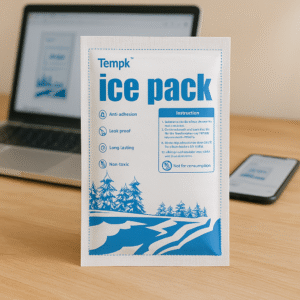
5. 2025 يكلف & Sustainability Hacks 💰🌱
| Hack | Average Saving | كيف تعمل |
|---|---|---|
| Autoship Subscription | 8–12 % / lb | Lock 6‑mo volume; supplier plans production |
| Regional Depots | 6–9 % freight | Shorter zones reduce surcharge & ice weight |
| Hybrid PCM Combo | 10–18 % weight | Replace 30 % ice with –25 °C PCM bricks |
| Reusable VIP Liner (6× cycle) | US $1.22 / parcel | أقل الجليد + landfill diversion |
| Route Optimizer | حتى $4 / package | Avoid zone 8 air legs, throttle peak fees |
6. التكنولوجيا الناشئة & Market Trends 🚀
-
IoT‑enabled “smart lids” tweet live CO₂ ppm to carriers—already cutting haz‑mat holds 22 %.
-
Closed‑loop CO₂ capture from breweries slashes cradle‑to‑gate emissions 45 %.
-
Hybrid phase‑change liners reach –30 °C and re‑freeze in 6 h, making reverse logistics viable.
-
Speakable Mark‑up في أقسام HowTo يعزز إمكانية رؤية البحث الصوتي (40 أصبحت % من طلبات البحث عن البقالة تعتمد الآن على الصوت).
-
الاتحاد الأوروبي & تعريفات الكربون CA قد يضيف 0.04 يورو/كجم من ثاني أكسيد الكربون في عام 2026 - ويعد الاعتماد المبكر للغاز المعاد تدويره بمثابة تحوط.
7. المزالق المشتركة (وإصلاحات سهلة) ⚠️✅
| شرك | تأثير | حل سريع |
|---|---|---|
| حزم PCM تحت التجميد | تصل شبه مذابة | تجميد شقة, -25 درجة مئوية, ≥8h |
| مبردات رغوة محكمة الغلق | انتفاخ الصندوق / تمزق | حفر فتحات تهوية مقاس 6 مم |
| استخدام الماء المثلج ل > ممرات 24 ساعة | تذوب & تسرب | قم بالتبديل إلى الثلج الجاف أو -25 درجة مئوية PCM |
| لا يوجد مخزن مؤقت لدرجة الحرارة للتأخير | استرداد الأضرار | أضف 20% ثلجًا إضافيًا أو PCM احتياطيًا |
| ملصق المواد الخطرة مفقود | رفض الناقل & بخير | قم بطباعة ملصقات UN1845 مسبقًا عند الخروج |
8. الأسئلة الشائعة ❓
❄️ هل يمكنني وضع عبوات الثلج الجاف في الأمتعة المسجلة على متن الطائرة?
نعم.
تسمح الخطوط الجوية عادةً بما يصل إلى 2.5 كجم (5.5 رطل) of solid CO₂ per passenger if it is packed in a حاوية تنفيس and labeled with و 1845.
Gel‑based PCM packs have no hazardous material limit if they are completely frozen.
📦 How many packs do I need for a 15 L cooler on a 48 h trip?
Use the calculator above. ل 48-hour duration, سوف تحتاج:
-
8 كيلوغرام من الثلج الجاف, أو
-
10 kg of –25 °C PCM bricks, which are safer for air transport.
🌱 Is recycled CO₂ dry ice truly eco‑friendly?
نعم.
Lifecycle analysis shows that using معاد تدويرها results in a 38 % lower carbon footprint compared to virgin CO₂ and grid-powered reefers along similar logistics routes.
🚮 How do I dispose of leftover dry ice?
Allow dry ice to sublimate in a well-ventilated area.
⚠️ Never dispose of it in a sink or sealed trash bin, as it may cause pressure build-up or damage.
9. الوجبات الرئيسية & Next Steps 🎯
-
Dry‑ice packs remain mandatory للبضائع المجمدة > 24 h.
-
اتبع 4 kg / day × 1.2 buffer formula for weight planning.
-
Buy from ISO‑audited suppliers with ≥ 70 % CO₂ recovery and same‑day pelletizing.
-
تنفيس, ملصق, and monitor every parcel to meet IATA, يو بي إس, و فيديكس 2025 قواعد.
-
Leverage PCM hybrids, بطانات VIP, and autoship contracts to cut costs by double‑digits.
Ready to optimize every shipment?
• Book a 15‑minute consult with a Tempk cold‑chain engineer (no pitch, just ROI math).





















